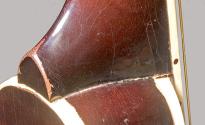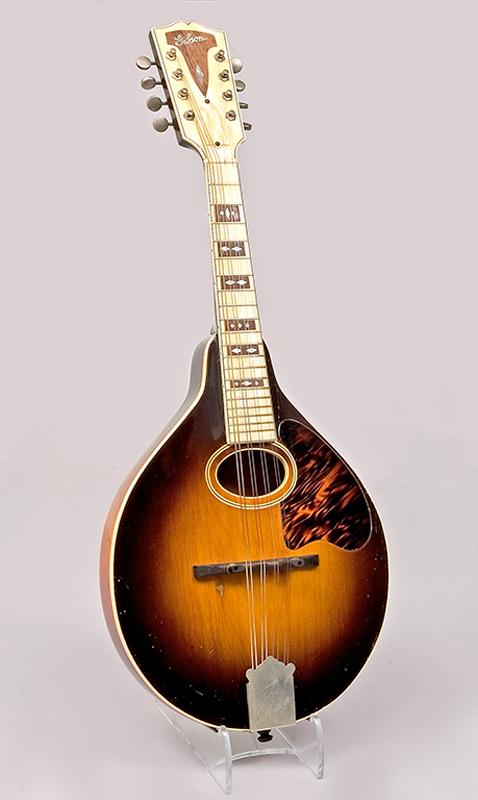Advanced Search
Plucked Strings
Mandolins
Mandolin
Maker: Gibson, Inc.
Date: 1937
Place Made:Kalamazoo, Michigan, United States, North America
Model: Century Model Style A-C (Century of Progress)
Serial No: 270C 8 (factory order number)
SignedInlaid in mother-of-pearl on headstock: Gibson
Stamped in cursive lettering on tailpiece: The / Gibson
Stamped in cursive lettering on tailpiece: The / Gibson
MarkingsRubber-stamped in black ink on neck block, the number “8” written in pencil: 27.0. C / 8
DescriptionThe Century Model A-C mandolin was one of three models (the other two were guitars) made by Gibson to commemorate the 1933-1934 Century of Progress Exhibition in Chicago. Based on Gibson's popular pear-shaped Model A, the A-C featured a special pearloid fretboard and maple back and ribs.
Stringing: eight steel strings
Soundboard: two-piece spruce: medium grain broadening slightly toward the flanks
Back: flat, one-piece, slab-cut maple: irregular broad curl descending from treble to bass
Ribs: two-piece, slab-cut maple: plain on bass side; faint, broad curl on treble side
Head: mahogany veneered with white pearloid and T-shaped rosewood piece, bound in white celluloid with black celluloid purfling strip; rosewood inlaid with mother-of-pearl notched diamond and mother-of-pearl “Gibson”; pearloid, bell-shaped truss rod cover secured with nickel-plated steel slot-head screws
Neck: mahogany; integral with head
Heel cap: none; neck heel flush with back
Binding: white celluloid; no additional trim
Fingerboard: white pearloid bound in white celluloid with black celluloid purfling strip; 20 nickel-silver frets; rosewood block inlays behind 3rd, 5th, 7th, 10th, 12th, and 15th frets; three mother-of-pearl diamonds inlaid in rosewood blocks behind 3rd, 10th, and 15th frets; two mother-of-pearl diamonds inlaid in rosewood blocks behind 5th, 7th, and 12th frets; single imitation tortoise-shell celluloid side dots behind 3rd, 5th, 7th, 10th, and 15th frets; double imitation tortoise-shell celluloid side dots behind 12th fret
Nut: bone
Bridge: two-piece ebony with brass screws
Tailpiece: nickel-plated brass with decoratively cut upper edge; secured to lower rib with three nickel-plated steel, dome-headed screws
Tuners: two sets of chrome-plated steel worm-gear machine tuners; nickel-plated brass heads
Endpin: ebony with mother-of-pearl eye
Rosette: oval; three ply (white-black-white) celluloid purfling strips set in from inside edge; edge bound in white celluloid
Pick guard: imitation tortoise-shell celluloid
Lacquer: dark brown sunburst with fine craquelure
Linings: kerfed maple
Neck block: mahogany, curved to fit upper bouts
End block: mahogany
Top braces: one spruce top brace with tapered ends
Back braces: one spruce back brace with tapered ends
Stringing: eight steel strings
Soundboard: two-piece spruce: medium grain broadening slightly toward the flanks
Back: flat, one-piece, slab-cut maple: irregular broad curl descending from treble to bass
Ribs: two-piece, slab-cut maple: plain on bass side; faint, broad curl on treble side
Head: mahogany veneered with white pearloid and T-shaped rosewood piece, bound in white celluloid with black celluloid purfling strip; rosewood inlaid with mother-of-pearl notched diamond and mother-of-pearl “Gibson”; pearloid, bell-shaped truss rod cover secured with nickel-plated steel slot-head screws
Neck: mahogany; integral with head
Heel cap: none; neck heel flush with back
Binding: white celluloid; no additional trim
Fingerboard: white pearloid bound in white celluloid with black celluloid purfling strip; 20 nickel-silver frets; rosewood block inlays behind 3rd, 5th, 7th, 10th, 12th, and 15th frets; three mother-of-pearl diamonds inlaid in rosewood blocks behind 3rd, 10th, and 15th frets; two mother-of-pearl diamonds inlaid in rosewood blocks behind 5th, 7th, and 12th frets; single imitation tortoise-shell celluloid side dots behind 3rd, 5th, 7th, 10th, and 15th frets; double imitation tortoise-shell celluloid side dots behind 12th fret
Nut: bone
Bridge: two-piece ebony with brass screws
Tailpiece: nickel-plated brass with decoratively cut upper edge; secured to lower rib with three nickel-plated steel, dome-headed screws
Tuners: two sets of chrome-plated steel worm-gear machine tuners; nickel-plated brass heads
Endpin: ebony with mother-of-pearl eye
Rosette: oval; three ply (white-black-white) celluloid purfling strips set in from inside edge; edge bound in white celluloid
Pick guard: imitation tortoise-shell celluloid
Lacquer: dark brown sunburst with fine craquelure
Linings: kerfed maple
Neck block: mahogany, curved to fit upper bouts
End block: mahogany
Top braces: one spruce top brace with tapered ends
Back braces: one spruce back brace with tapered ends
DimensionsTotal mandolin length: 651 mm (25-5/8″)
Back length: 347 mm (13-21/32″)
Upper bout width: 62 mm (2-7/16″)
Lower bout width: 256 mm (10-1/16″)
Rib height (including edging) at heel: 47 mm (1-7/8″)
Rib height, at waist: 45 mm (1-25/32″)
Rib height, at end block: 47 mm (1-7/8″)
Head length: 162 mm (6-3/8″)
Head width, top: 73 mm (2-7/8″)
Head width, bottom: 58 mm (2-9/32″)
Neck length (nut to ribs): 153 mm (6″)
Neck width, nut: 30 mm (1-3/16″)
Neck width, heel: 38 mm (1-1/2″)
Soundhole height: 41 mm (1-5/8″)
Soundhole width: 65 mm (2-9/16″)
Vibrating string length (nut to bridge edge): E: 353 mm (13-29/32″); G: 354 mm (13-15/16″)
Back length: 347 mm (13-21/32″)
Upper bout width: 62 mm (2-7/16″)
Lower bout width: 256 mm (10-1/16″)
Rib height (including edging) at heel: 47 mm (1-7/8″)
Rib height, at waist: 45 mm (1-25/32″)
Rib height, at end block: 47 mm (1-7/8″)
Head length: 162 mm (6-3/8″)
Head width, top: 73 mm (2-7/8″)
Head width, bottom: 58 mm (2-9/32″)
Neck length (nut to ribs): 153 mm (6″)
Neck width, nut: 30 mm (1-3/16″)
Neck width, heel: 38 mm (1-1/2″)
Soundhole height: 41 mm (1-5/8″)
Soundhole width: 65 mm (2-9/16″)
Vibrating string length (nut to bridge edge): E: 353 mm (13-29/32″); G: 354 mm (13-15/16″)
Terms
Credit Line: John R. Barmeyer Collection, 2005
Not on view
Object number: 10868


















